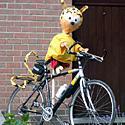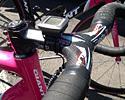
Recently on Cyclingnews.com |
91st Tour de France - July 3-25, 2004
Tour tech - July 21, 2004
Edited by Anthony Tan
Got tech? Send press releases, news, and tech questions to the Cyclingnews tech-heads.
Earth to Waterloo...
Satellite-grade carbon fibre used for Lance's L'Alpe d'Huez climbing bike

|
Trek's Brand Manager Zapata Espinoza shared first with Cyclingnews details on the new 55 GSM OCLV carbon fibre material used in Lance Armstrong's one-of-a-kind Trek Madone SSL, built specifically for today's TT stage to L'Alpe d'Huez.
By using unique carbon fibre material normally used for satellite construction, Trek found a way to bring their OCLV frame technology to a new level to meet the challenge of a super-light yet strong uphill TT and climbing bike. 55 GSM OCLV uses a carbon fibre lay-up process that, according to Trek's Espinoza, "is far more meticulous and challenging than that we use for any other OCLV frame we build".
If the stress tests on the Madone SSL showed that OCLV 55 GSM wasn't the optimum material, Trek used OCLV 110 to enhance durability. Pictured here is a Trek tester readying a Madone SSL for blast off. Or something.
A HEDs-up: Spot 'em if you can

|
It's no secret to see unofficial team equipment popping up on riders' bikes during races like Le Tour; HED Wheels happens to be one of those brands on the spot-'em-if-you-can list.
"We try to avoid names, but it is pretty easy to spot some of our gear at the Tour," says founder and chief designer Steve Hed to Cyclingnews. "HED has several new products for 2005 that are being used in the pro pelotons in Europe and the US. Primarily, they are the full carbon H3 wheels (H3C), new clip-on bars, and new carbon aerobar extensions."
Hed informs Cyclingnews that H3C wheels are no longer a prototype but a standard production wheel. "The wheels adopt same shape as the standard H3 and the same rim profile, but the change to a carbon brake surface makes the wheel much lighter," he says. According to HED, the entire 50mm rim section on the wheel weighs 270 grams, with the complete wheel weights being 670 grams for the front and 880 grams on the rear.
A little trickier to spot were HED's new carbon aerobar extensions (pictured) at the prologue, which adopt an S-type bend for improved comfort and aerodynamics. Hed explains: "When accelerating or climbing, racers make more power by sliding to the nose of the saddle and rising up slightly. The upward bend on the bars aligns the wrist and forearm. When the wrist and forearm are aligned, upper arm and back muscles are more easily recruited to stabilise the lower back and hips for maximum power output. For top speed cruising, the hands go forward to the flats of the bars - the shoulders come down and slightly in. With the shoulders lower, frontal area and drag is reduced.
HED Wheels expects the extensions to be in full production later this year.
Integrated Erik: Erik Zabel's Deda Elementi integrated bar & stem combo

|
Now just a few points behind Aussie Robbie McEwen in the race for the maillot vert, T-Mobile's Erik Zabel is hoping the light and rigid Alanera integrated stem and bars from Deda Elementi might give him an edge for the green tunic. Integrated stem and bars seem to be more popular in the Tour peloton this year, although the majority of the riders are still using non-integrated 1'1/8" stems.
Dove' e Gibo? (Where is Gibo) Gilberto Simoni's SRM-equipped Team Saeco Cannondale CAAD7
In a similar vein to Jens Voight's SRM-equipped Team CSC Cervélo R2.5 we reviewed the other day, Gilberto Simoni's Team Saeco Cannondale Six13 also used wireless SRM technology on Stage 11 of the Tour de France. Here, SRM inventor Uli Schoberer helps Simoni with his wireless set-up, so his directtore sportivo Giuseppe Martinelli could analyse how Gibo was tracking before the Alpine stages that were still to come.

|
So far in the Tour, Simoni has encountered bad luck, average form and poor morale, so we asked Martinelli what was up with his star rider and the vaunted 'Treno Rosso' (Red Train) that dominated the Giro d'Italia not so long ago. Martino responded by saying: "As you know, any team's performance at the Tour de France depends on how the team captain is riding.
"If the captain is going well, he's got the entire team behind him. Right now, I think Gilberto still has to figure out what he wants to accomplish in this Tour. I hope that the mountains will bring out the best in him; the team is kind of waiting to see how Simoni does to ride well. But I think in the next few days, we'll know a lot more about what is going to happen in this year's Tour," he added.
Martinelli's predictions couldn't have been more accurate. Gibo found his climbing legs on yesterday's Alpine stage to Villard-de-Lans and is now lying 12th overall on the eve of the crucial time trial to L'Alpe d'Huez, while the podium for this year's Tour will most likely come from the top five riders on the general classification.
Photography
Images by Tim Maloney/Cyclingnews
- A Trek tester readying a Madone SSL for blast off. Or something.
Images by Steve Santel/HED Wheels
- HED's new carbon aerobar adopts an S-type bend for improved comfort and aerodynamics.
Images by Tim Maloney/Cyclingnews
- Deda Elementi's Alanera integrated stem and bars.
- Erik Zabel is hoping the Alanera bar and stem will give him the edge to snatch the green jersey from Robbie McEwen.
- SRM inventor Uli Schoberer helps Gilberto Simoni with his wireless SRM set-up Gibo prior to the start of Stage 11.
Coming tomorrow in Tour tech: Bikes of the 2004 Tour de France, Part II
